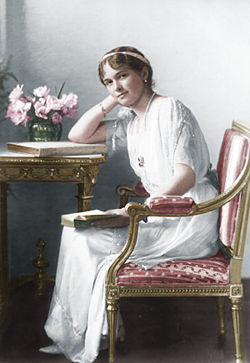In 1900 summer would have found the park full of people and its lakes dotted with boats. Tsarskoe Selo was a short 15 minute ride from Petersburg by train and many pople took advantage of the ease of transport to visit the town and its attractions. Bseides day visitors the city also had many temporary residents who rented datchas during the summer. The aristocracy had long made Tsarskoe Selo a preferred get-away location and their palaces and villas lined the smart streets.
 Left: Grand Duchess Olga.
Left: Grand Duchess Olga.
The park of the Catherine Palace was open to the public, although it was still used by the Imperial family in 1900, to the consternation of the Secret Police, who did everything they could to keep the people and the Tsar's family apart in fear of terrorism. Once day the Grand Duchess Olga, daughter of Nicholas II was walking in the park with a lady-in-waiting. It was a beautiful day and the park should have been full of visitors. Instead Olga didn't see anyone on the paths, but only off in the distance. People seemed to be avoiding her - even running away. When she learned that police were running a long ahead of them, telling people to move away she was very upset. Not only was she disappointed at not meeting people, she was also distressed to learn that people who were accidently in her way were being disturbed for her sake.
It was very difficult for people to meet the Imperial family. People who ran into them casually and by accident were interrogated by the police who wanted to know who they were, their occupation and what they were doing that day. Friends and casual associates of the family could suddenly discover they were under police surveillance. This was not only to check them out but also to protect them from enemies of the Dynasty who were know to target friends of the Romanovs. This harassment definitely out a damper on the prospects of new friendships for the family and they were cocooned and isolated.
The picture above shows a mechanical table in one of the pavilions. This table was designed to serve the Tsar's guests without the visable presence of servants. The "magical' table was constructed to rise up from the floor fully set. Each course as it was prepared and served was elevated from underneath to the guest, after the course was completed the used plate would vanish from where it came. When dining was completed the guests would step away and the table would fold up and disappear altogether. This 18th century curiosity was kept in good working order up until the revolution. There were a number of curiosities like this in the park. The Tsars brought some of them here to Tsarskoe Selo specifically for the enjoyment of the public when the park was open.
In 1900 the various attractions of the park were clearly pointed out in guide books and routes laid out for efficiently seeing them all. Some of the pavilions were wide open and there were few guards about. Visitors could walk almost anywhere they chose and enjoy the park just like they were a member of the Romanov family. Vandalism before the revolution was very rare.
Next photograph: Imperial Baggage Wagons
For a small map of the St. Petersburg area click here.
To see a large map of the center
of St. Petersburg go here.
Comments on the website should be sent to Bob
Atchison.

